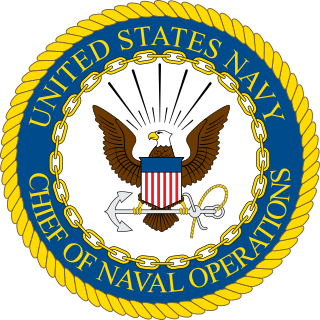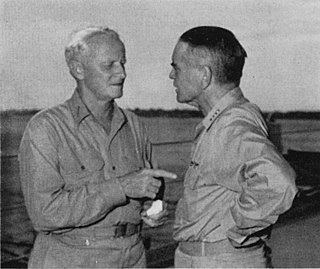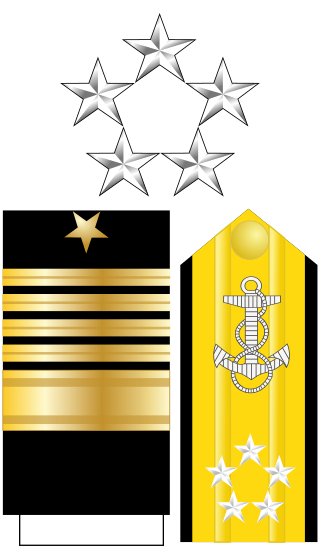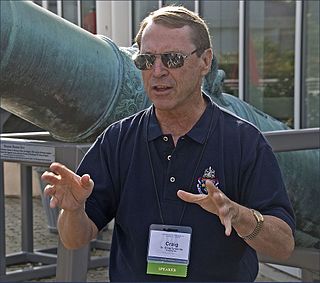Related Research Articles

The chief of naval operations (CNO) is the highest-ranking officer of the United States Navy. The position is a statutory office held by an admiral who is a military adviser and deputy to the secretary of the Navy. The CNO is also a member of the Joint Chiefs of Staff and in this capacity, a military adviser to the National Security Council, the Homeland Security Council, the secretary of defense, and the president.

Chester William Nimitz was a fleet admiral in the United States Navy. He played a major role in the naval history of World War II as Commander in Chief, US Pacific Fleet, and Commander in Chief, Pacific Ocean Areas, commanding Allied air, land, and sea forces during World War II.

The Battle of Leyte Gulf 23–26 October 1944, was the largest naval battle of World War II and by some criteria the largest naval battle in history, with over 200,000 naval personnel involved.

William Frederick "Bull" Halsey Jr. was an American Navy admiral during World War II. He is one of four officers to have attained the rank of five-star fleet admiral of the United States Navy, the others being William Leahy, Ernest J. King, and Chester W. Nimitz.

Raymond Ames Spruance was a United States Navy admiral during World War II. He commanded U.S. naval forces during the Battle of the Philippine Sea, one of the most significant naval battles of the Pacific Theatre. He also commanded Task Force 16 at the Battle of Midway, comprising the carriers Enterprise and Hornet. At Midway, dive bombers from Enterprise sank four larger carriers of the Imperial Japanese Navy. Most historians consider Midway the turning point of the Pacific War.

Ernest Joseph King was a fleet admiral in the United States Navy who served as Commander in Chief, United States Fleet (COMINCH) and Chief of Naval Operations (CNO) during World War II. He was the U.S. Navy's second-most senior officer in World War II after Fleet Admiral William D. Leahy, who served as Chief of Staff to the Commander in Chief. He directed the United States Navy's operations, planning, and administration and was a member of the Joint Chiefs of Staff and Combined Chiefs of Staff.

William Daniel Leahy was an American naval officer. The most senior United States military officer on active duty during World War II, he held several titles and exercised considerable influence over foreign and military policy. As a fleet admiral, he was the first flag officer ever to hold a five-star rank in the U.S. Armed Forces.

"The world wonders" is a phrase which rose to notoriety following its use during World War II when it appeared as part of a decoded message sent by Fleet Admiral Chester Nimitz, Commander in Chief, U.S. Pacific Fleet, to Admiral William Halsey Jr. at the height of the Battle of Leyte Gulf on October 25, 1944. The words, intended to be without meaning, were added as security padding in an encrypted message to hinder Japanese attempts at cryptanalysis, but were mistakenly included in the decoded text given to Halsey. Halsey interpreted the phrase as a harsh and sarcastic rebuke, and as a consequence dropped his futile pursuit of a decoy Japanese carrier task force, and, belatedly, reversed some of his ships in a fruitless effort to aid United States forces in the Battle off Samar.

William Harrison Standley was an admiral in the United States Navy, who served as Chief of Naval Operations from 1933 to 1937. He also served as the U.S. ambassador to the Soviet Union from 1941 until 1943.

Fleet admiral is a five-star flag officer rank in the United States Navy whose rewards uniquely include active duty pay for life. Fleet admiral ranks immediately above admiral and is equivalent to General of the Army and General of the Air Force.
The United States Fleet was an organization in the United States Navy from 1922 until after World War II. The acronym CINCUS, pronounced "sink us", was used for the Commander in Chief, United States Fleet. This was replaced by COMINCH in December, 1941, under the Executive Order 8984, when it was redefined and given operational command over the Atlantic, Pacific, and Asiatic Fleets, as well as all naval coastal forces. The Executive Order 9096 authorized the offices of the CNO and COMINCH to be held by a single officer; Admiral Ernest J. King was first to do so, and in 1944 was promoted to the five-star rank of fleet admiral.

Vice Admiral Robert Lee Ghormley was an admiral in the United States Navy who served as commander, South Pacific Area during World War II. Ghormley was long considered to be an ineffective leader–overly cautious, pessimistic, and even defeatist–but recent scholarship has argued that while he may not have been an inspiring leader, he performed well enough under difficult circumstances.

Thomas Cassin Kinkaid was an admiral in the United States Navy, known for his service during World War II. He built a reputation as a "fighting admiral" in the aircraft carrier battles of 1942 and commanded the Allied forces in the Aleutian Islands Campaign. He was Commander Allied Naval Forces and the Seventh Fleet under General of the Army Douglas MacArthur in the Southwest Pacific Area, where he conducted numerous amphibious operations, and commanded an Allied fleet during the Battle of Leyte Gulf, the largest naval battle of World War II and the last naval battle between battleships in history.

Miles Rutherford Browning was an officer in the United States Navy in the Atlantic during World War I and in the Pacific during World War II. An early test pilot in the development of carrier-based Navy aircraft and a pioneer in the development of aircraft carrier combat operations concepts, he is noted for his aggressive aerial warfare tactics as a Navy captain on the Admiral's staff aboard USS Enterprise and at Nouméa during World War II. His citation for the Distinguished Service Medal states: "His judicious planning and brilliant execution was largely responsible for the rout of the enemy Japanese fleet in the Battle of Midway." Naval historian Craig Symonds disagrees, however, writing that "the citation claim that Browning was 'largely responsible' for the American victory at Midway, an assertion that some historians have taken seriously. .. is manifestly untrue."

John Sidney "Slew" McCain Sr. was a United States Navy admiral and the patriarch of the McCain military family. McCain held several commands during the Pacific War of World War II and was a pioneer of aircraft carrier operations. He and his son, John S. McCain Jr., were the first father-and-son pair to achieve four-star admiral rank in the U.S. Navy.

Craig Lee Symonds was the Distinguished Visiting Ernest J. King Professor of Maritime History for the academic years 2017–2020 at the U.S. Naval War College in Newport, Rhode Island. He is also Professor Emeritus at the U. S. Naval Academy, where he served as chairman of the history department. He is a distinguished historian of the American Civil War and maritime history. His book Lincoln and His Admirals received the Lincoln Prize. His book Neptune: The Allied Invasion of Europe and the D-Day Landings was the 2015 recipient of the Samuel Eliot Morison Award for Naval Literature.
The Samuel Eliot Morison Award for Naval Literature is for literature about the United States Navy. The award was planned in 1982 and first issued the next year by the New York Commandery of the Naval Order of the United States, who administers and chooses the winner which is a significant book on naval history from the prior year.

Pacific Crucible: War at Sea in the Pacific, 1941–1942 is the first volume in the Pacific War trilogy, written by historian Ian W. Toll. The book is a narrative history of the opening phase of the Pacific War, which took place in the eastern Pacific between the Allies and the Empire of Japan. It was published by W. W. Norton & Company in 2011 and 2012 (paperback) and was released as an audiobook narrated by Grover Gardner by Audible Studios in 2011. The following volume in the trilogy, The Conquering Tide: War in the Pacific Islands, 1942–1944, was published in 2014; the final volume in the trilogy, Twilight of the Gods: War in the Western Pacific, 1944–1945, was published in 2020.

The Conquering Tide: War in the Pacific Islands, 1942–1944 is the second volume in the Pacific War trilogy written by best selling author and historian Ian W. Toll. The book is a narrative history of the middle phase of the Pacific War, which took place in the central and southern Pacific between the Allies and the Empire of Japan. It was published by W. W. Norton & Company in 2015 and 2016 (paperback). It was released as an audiobook narrated by P. J. Ochlan by Recorded Books in 2015. The first volume in the trilogy, Pacific Crucible: War at Sea in the Pacific, 1941–1942, was published in 2011; the final volume in the trilogy, Twilight of the Gods: War in the Western Pacific, 1944–1945, was published in 2020.

Twilight of the Gods: War in the Western Pacific, 1944–1945 is the final volume in the Pacific War trilogy written by best selling author and historian Ian W. Toll. The book is a narrative history of the final phase of the Pacific War, that took place in the western Pacific between the Allies and the Empire of Japan. It was published by W. W. Norton & Company in 2020. It was also released as an audiobook narrated by P. J. Ochlan by Recorded Books in 2020. The first volume in the trilogy, Pacific Crucible: War at Sea in the Pacific, 1941–1942, was published in 2011; the second volume in the trilogy, The Conquering Tide: War in the Pacific Islands, 1942-1944, was published in 2015.
References
- ↑ World Cat authority file
- ↑ Contemporary authors new revision series. : Volume 225. Gale, 2012 ISSN 0275-7176. WorldCat
- ↑ WorldCat
- ↑ Borneman, Walter R. The Admirals: Nimitz, Halsey, Leahy, and King--the Five-Star Admirals Who Won the War at Sea. New York: Little, Brown and Co, 2012. ISBN 9780316097840
- ↑ "Latest NOUS Awards". Naval Order of the United States. Archived from the original on 2017-06-03. Retrieved December 23, 2017.
- ↑ "Previous Morison Book Awards". Naval Order of the United States, New York Commandery. Archived from the original on 2016-08-27. Retrieved December 23, 2017.
- ↑ Borneman, Walter R. MacArthur at War: World War II in the Pacific. New York: Little, Brown and Company, 2016. ISBN 9780316405324
- ↑ WorldCat
- ↑ WorldCat
- ↑ WorldCat
- ↑ WorldCat
- ↑ WorldCat
- ↑ [9780060503062 WorldCat]
- ↑ WorldCat,